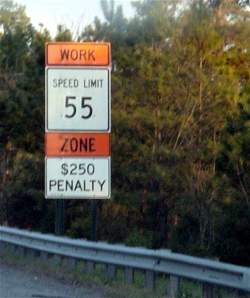There is a big section of I-40 near my home that is being widened. When they are doing construction like that here in North Carolina, they mark off and label the entire “Work Zone” and post a lower speed limit. Then they put up big signs to tell you, “$250 fine for speeding in the Work Zone.” The idea is to slow drivers down so that things are safer for the construction crew.

Why do they increase the fine in the Work Zone? The extra-large fine (and posting the size of the fine on prominent signs) is supposed to act as an extra-large deterrent to speeders. Many people would find $250 a big expense, and they would rather avoid it if they can by driving at the posted speed.
I was driving through that construction zone on I-40 the other night. I was driving the posted speed, as were the people around me. I was therefore surprised to have a Porsche blow past me at about 80 MPH.
If you think about it, however, this actually makes sense. The Porsche was worth $100,000 or so. The guy driving the Porsche clearly has plenty of money — he’s probably making $200,000 per year or more. What is $250 if you are making $200K per year? It is nothing, relatively speaking.
To someone who makes minimum wage, $250 is a big deal. A person working for minimum wage makes about $10,000 per year. $250 is more than a week’s wages. $250 is 2.5% of your annual income — it is a serious amount of money. But to someone who makes $200,000 a year, $250 is meaningless. It is only 0.125% of your annual salary. The deterrent effect is minimal — it is 1/20th the impact of a person making minimum wage.
Whether a construction worker is killed by a rich guy speeding in his Porsche, or killed by a minimum-wage guy in his second-hand Ford Escort, the result is the same — either way it is a tragedy for the family of the construction worker. So the goal of deterring speeding is just as important for rich and poor drivers. But how do you make the speeding fine just as “painful” for a rich person, so that it has the same deterrent effect?
The obvious way is to scale the fine based on income. So the sign does not say, “$250 fine for speeding”. Instead it says, “2.5%AI fine for speeding,” where 2.5%AI means “2.5 percent of annual income.” If you make $200,000 per year, the fine would work out to $5,000. The financial impact of the speeding ticket would be just as strong for a rich person as it is for a poor person. That way, the deterrent effect of the fine would be the same for everyone.
This same scaling idea could apply to many different aspects of our society. For example, in Time magazine this week, there is an editorial advocating a $1.00 per gallon tax on gasoline. The idea, according to the editorial, is this: “by adding a cost to the wanton consumption of gasoline, you actually encourage conservation, accelerate fuel efficiency, reduce pollution, cut traffic and help wean Americans off the oil that requires the U.S. to be so intimately involved in that wonderful cesspool of rival hatreds, the Middle East.”
Let’s assume that the average American uses 10 gallons of gasoline a week. This new gas tax would add approximately $520 per year to the price of gasoline. For a minimum wage worker, that is 5% of total income — a big penalty for using gasoline. For a rich person making $200,000 per year, however, $500 feels much smaller. Why not scale the tax to eliminate this disparity? To provide an equivalent disincentive for the person making $200,000 per year, the person would need to pay $20 per gallon in gasoline taxes. For a CEO making $2 million per year, the tax would be $200 per gallon.
“What???? $20 per gallon is nuts!” would be the reaction to that. However, it is no more nuts than charging a minimum wage worker $1 a gallon. In fact, it is exactly the same. A person making $200,000 per year makes 20 times more than a minimum wage worker. Therefore, from a “pain and disincentive” standpoint, $20 for the rich person is exactly the same as $1 for the poor person. So is $200 for the CEO.
Obviously the person writing the article in Time is making $200,000 per year or more, and that is the whole point of pondering this question. For him, $1 per gallon is relatively meaningless, so it is easy to propose.
$20 or $200 per gallon sounds ridiculous initially, until you realize that $1 per gallon feels exactly like that to a minimum wage worker. If we scaled all of the fines and tax disincentives so that everyone felt equal “pain” from them, we would have a much fairer system for everyone.
